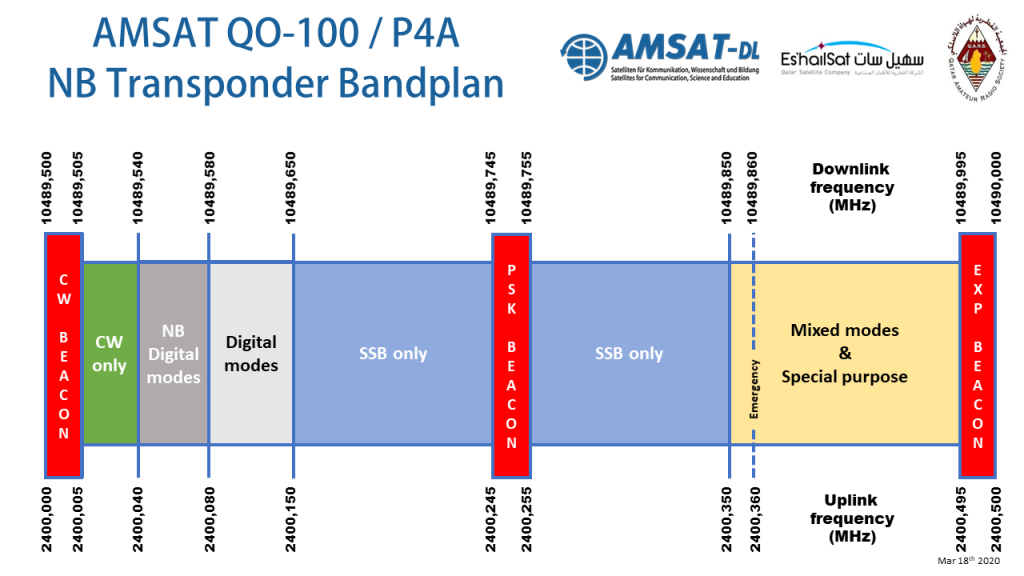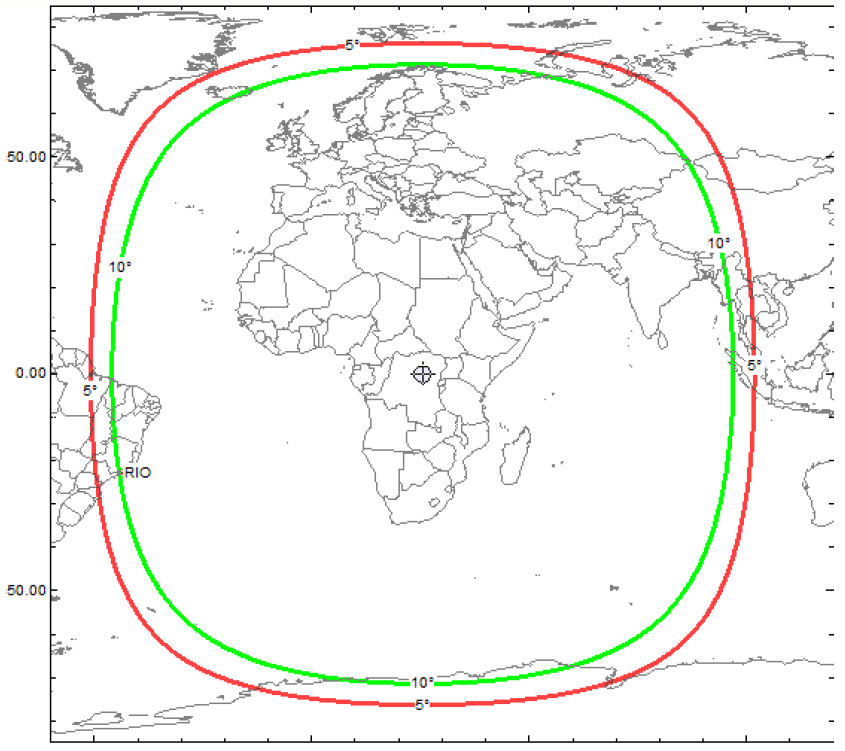
So far in the $50 Ham series, I’ve concentrated mainly on the VHF and UHF bands. The reason for this has to do mainly with FCC rules, which largely restrict Technician-level licensees to those bands. But there’s a financial component to it, too; high-frequency (HF) band privileges come both at the price of learning enough about radio to pass the General license test, as well as the need for gear that can be orders of magnitude more expensive than a $30 handy-talkie radio.
But while HF gear can be expensive, not everything needed to get on the air has to be so. And since it’s often the antenna that makes or breaks an amateur radio operator’s ability to make contacts, we’ll look at a simple but versatile antenna design that can be adapted to support everything from a big, powerful base station to portable QRP (low-power) activations in the field: the end-fed half-wave antenna.
Making a Match
There are plenty of hams out there for whom antenna building is the be-all and end-all of the hobby. I get that; there’s a non-zero amount of wizardry that goes into designing an antenna that will do what you want it to do electrically, and plenty of engineering involved in making sure it stands up to the elements. I think the latter aspect of antenna building is more attractive to me personally. Getting an antenna to survive wind, snow, sun, and rain is an interesting challenge, so I tend to spend more time thinking about the mechanical aspects of design that someone has already worked the RF bugs out of.
So I set out looking for an antenna that would work for my situation. Perhaps the easiest antenna to build is the classic half-wave dipole. These have two elements, each one-quarter of the design wavelength, radiating out from a central feed point, which is where the coaxial cable feedline attaches. There are elaborations and complications, of course, but the basic issue for me is the central feed point. My shack is located at the very back corner of my property, so it’s difficult to rig an antenna like that without a long feedline, which can introduce unacceptable signal losses. Plus, a dipole for the 80-meter band would be 40 meters end-to-end, and that would be hard to fit across my long, narrow suburban lot.
For my purposes, the end-fed half-wave (EFHW) antenna is a good choice. It’s exactly what it sounds like: a chunk of wire one-half of a wavelength long (in my case, 40 meters long so I can work the 80 meter band) that is fed from its end. But it’s not as simple as cutting a 40 meter long piece of wire and sticking it on your radio. The problem is that the impedance of an antenna varies as the feedpoint moves away from the center. The impedance increases all the way up to about 2,500 ohms when the feedpoint reaches the end of the wire, which would be a very bad match indeed for a transceiver expecting a 50 ohm load.
To fix this, EFHW antennas need a transformer to match impedances. When used to match impedance between a balanced antenna, like a dipole, and an unbalanced feedline, like coaxial cable, these are referred to as “baluns”. In this case, though, both the antenna and the coax feedline are unbalanced, so the transformer I built is technically an “unun”. Whatever you call it, it’s a pretty easy build.
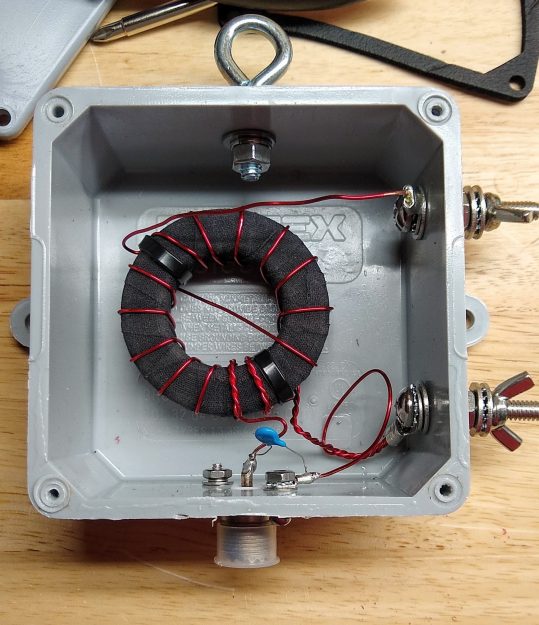
I followed the excellent instructions provided by Steve Nichols (G0KYA) to wind my 49:1 autotransformer. It’s basically just big ferrite toroid core — I got mine from eBay, but there are plenty of options on Amazon — with a few windings of magnet wire. My core is an FT-240-61, which means its outside diameter is 2.4 inches and it’s made of type 61 material. I used 18 AWG magnet wire for the windings. While I was winding it, I noticed that the lacquer coating on the magnet wire was getting nicked by the edges of the ferrite core. I rewound it after covering the toroid with cloth friction tape to cushion the edges a bit — shorts would be no bueno in something designed to handle 100 Watts of transmitter output.
Like I said, a lot of the fussing I did with this transformer had to do with making it work mechanically. I mounted it into a sturdy plastic electrical enclosure and provided stainless steel fittings for connecting the antenna wire and the ground connection. I also installed an eye bolt to tether the antenna wire. A good-quality SO-239 socket for the feedline connection and a 100 pF high-voltage capacitor for better matching on the higher frequency bands completed the transformer. With luck, this antenna should cover 80 m to 10 m bands.
Pushing Rope
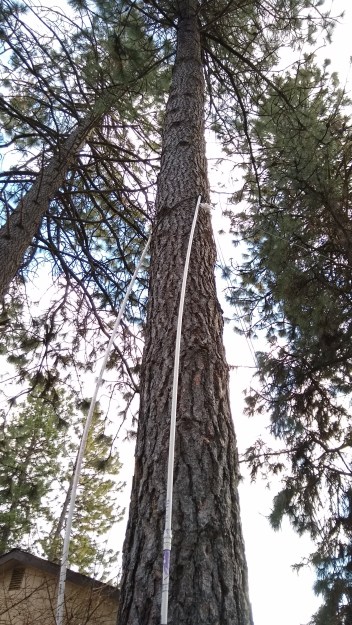
As luck would have it, my lot is just about 150 feet deep, and I’m both blessed and cursed by a lot of very tall, very sturdy Ponderosa pines. The length of my lot and the location of the trees allows for a full 40-meter wire in a sort of “inverted-L” configuration. My plan was to slope the wire from the transformer up as far as possible in the first tree, then run it horizontally to an anchor point in a second tree.
This sounds far, far easier than it actually is. While many hams have had good luck suspending antennas from lines lofted over branches, my pine trees have all been pruned of their lower branches, with the first living branches more than 40′ (12 meters) above the ground. I opted for a “work smarter” approach and came up with an idea to basically push a loop of rope up the tree using PVC pipe as a push stick. Although the roughness of the Ponderosa bark constantly snagged the nylon rope and the PVC pipe flopped around as I added sections , it actually worked well enough to get the anchor point about 25′ (7.5 m) above the ground — not much higher than I could have gotten with my 24′ ladder, but with a whole lot less risk of falling to my death.
The anchor point was set in the other tree using a similar method, which drew a lot of attention from the neighbors. One should always seize such opportunities to do a little “ham goodwill” outreach, and I assured the neighbors that I wouldn’t be sterilizing their kids or interfering with their TV reception. In an example of karma, though, the tree I was working in decided to shed a dead branch the next day, which came down and damaged my neighbor’s Durango. It clearly came from much higher in the tree than I was working, but it still caused a little bit of the old stink eye.
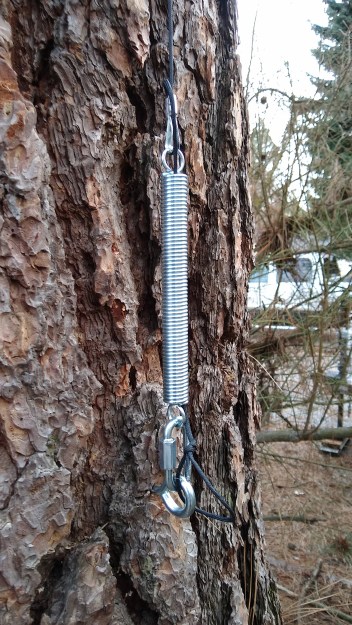
One of the most important parts of using trees as anchors for long-wire antennas is dealing with sway. Trees move around quite a bit, and if you anchor a wire tightly between two trees without allowing for them to move with the wind, sadness will ensue. And yet, you want your wire to stay more or less taut, since its shape affects its performance. There are a couple of ways to deal with this, and I chose to use clothesline pulleys at both my anchor points. At the midpoint, the wire runs through the pulley; at the end anchor, the wire is tied off to a length of strong nylon cord through a dogbone insulator. That cord runs through the pulley and down the trunk of the tree to an anchor point through a strong spring. When the trees sway, the antenna can extend or retract by several inches without sagging or snapping.
On the Air at Last
I have to admit that this installation isn’t actually complete yet. Antennas really should be properly grounded, and I’m keen to pound a ground rod in near the transformer. However, both the mains feeder for my house and the primary feeder for the entire neighborhood are buried directly under our back fence, making this a high-risk endeavor. As good as underground location services are, I’m not keen to test their precision with my precious self. So I’m going to wait for a decent ground.
Still, I couldn’t help but want to try this antenna out, so to keep RF out of the shack, I wound a 10-turn air-core choke on the feedline and hooked it up. I haven’t made any QSOs yet, but using WSPR, the Weak Signal Propagation Reporter system, I was able to reach four continents over a 24-hour period on the 80-, 40-, 30-, and 20-meter bands.
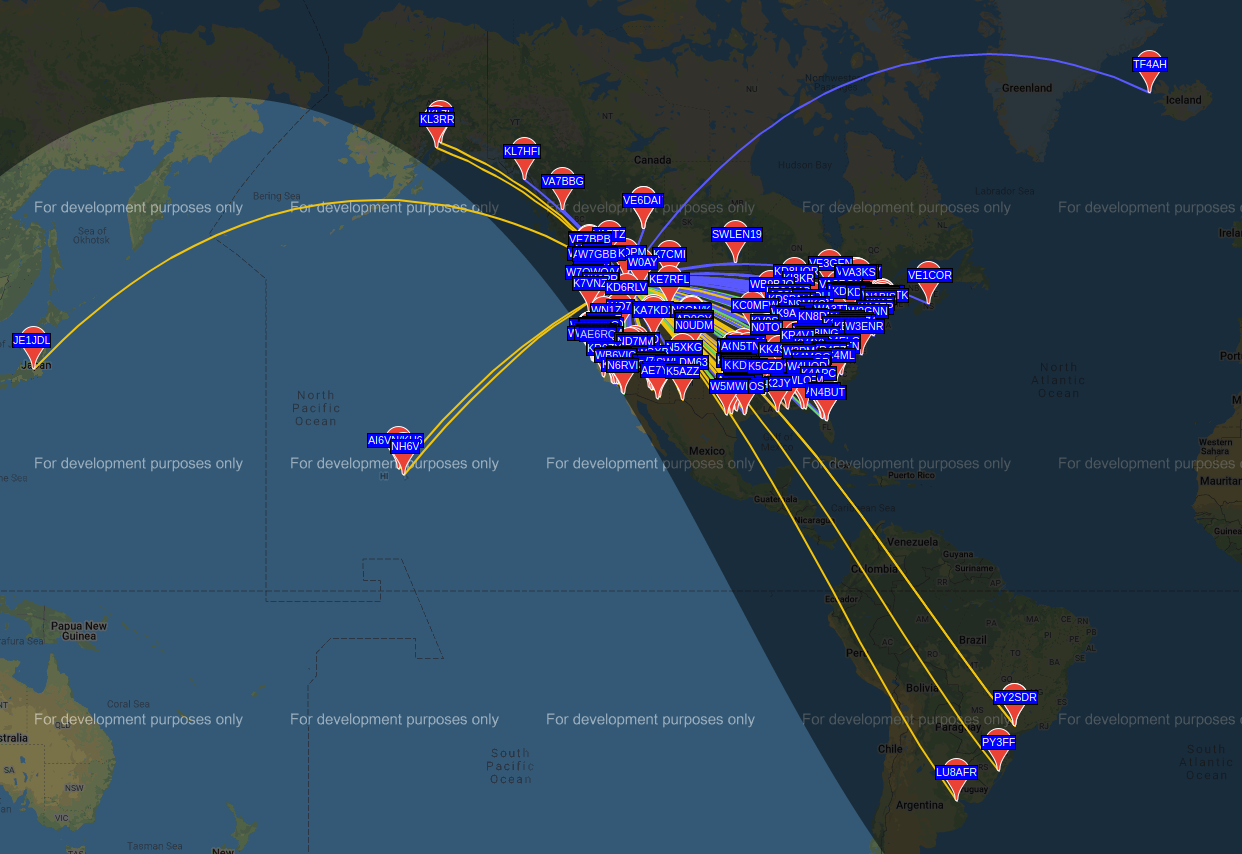
And speaking of WSPR, that and other digital modes are what we’ll be talking about in the next installment of the $50 Ham. Spoiler alert: despite my previous gripes, I think I’m falling in love with ham radio again.
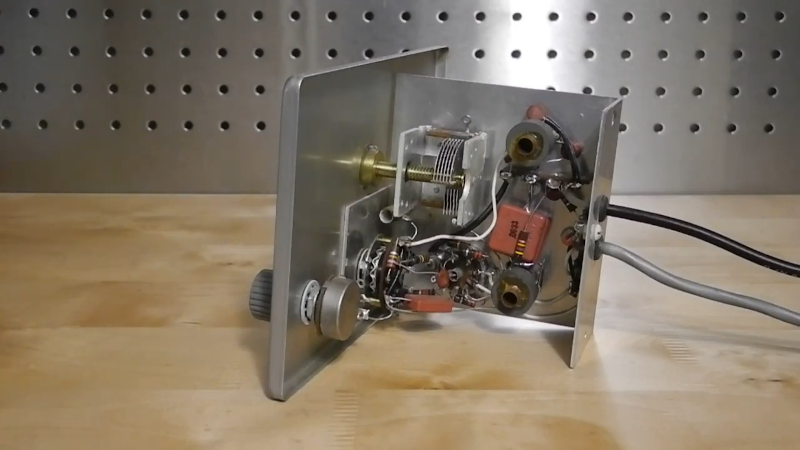


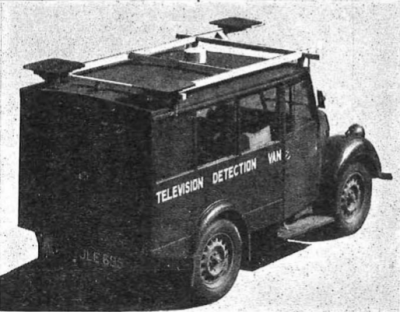
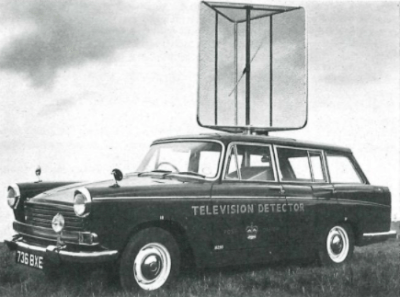
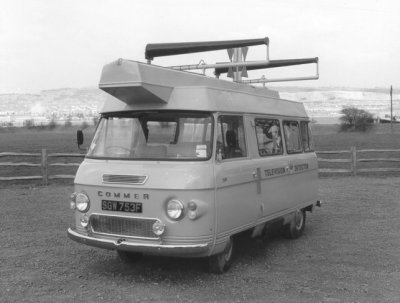


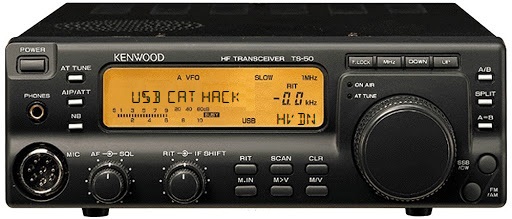
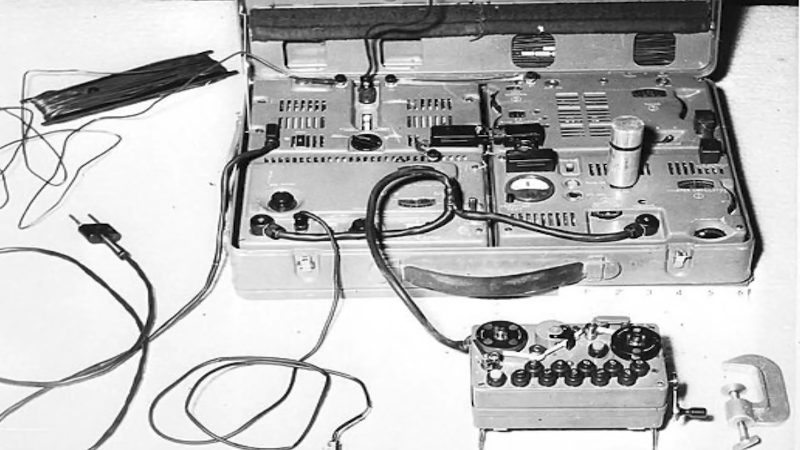

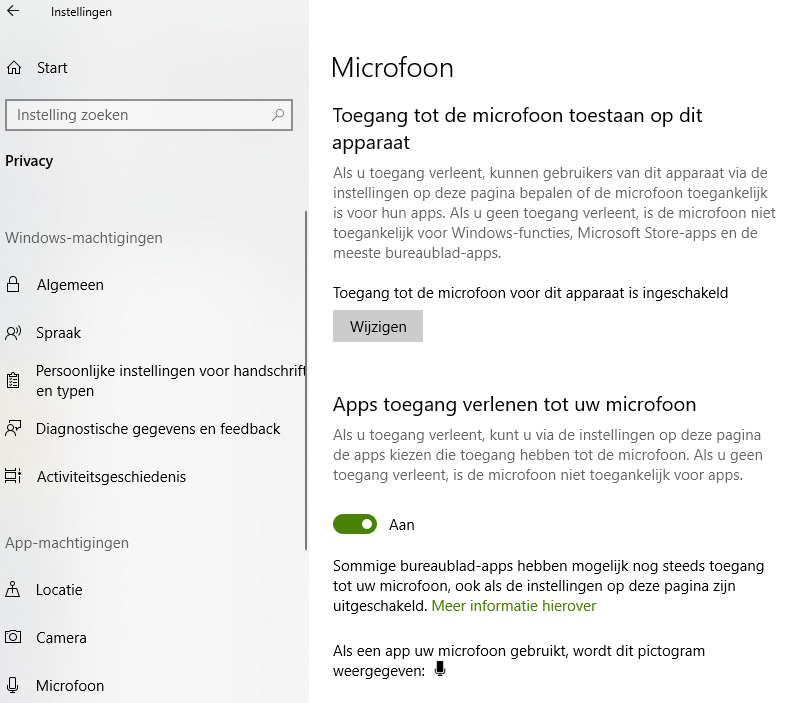


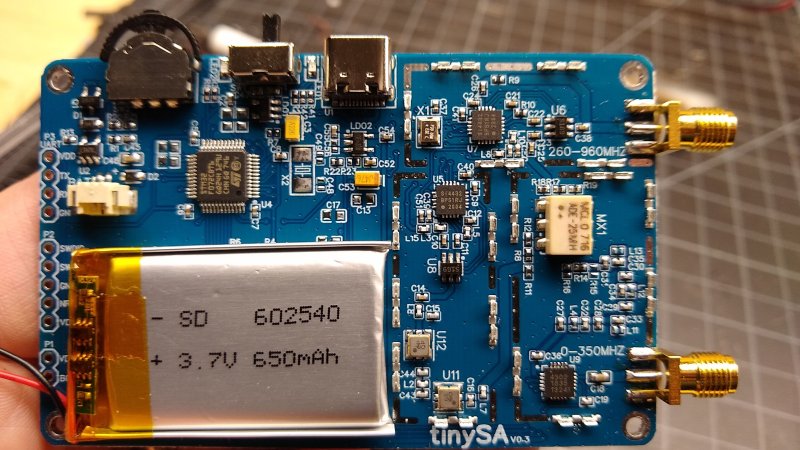

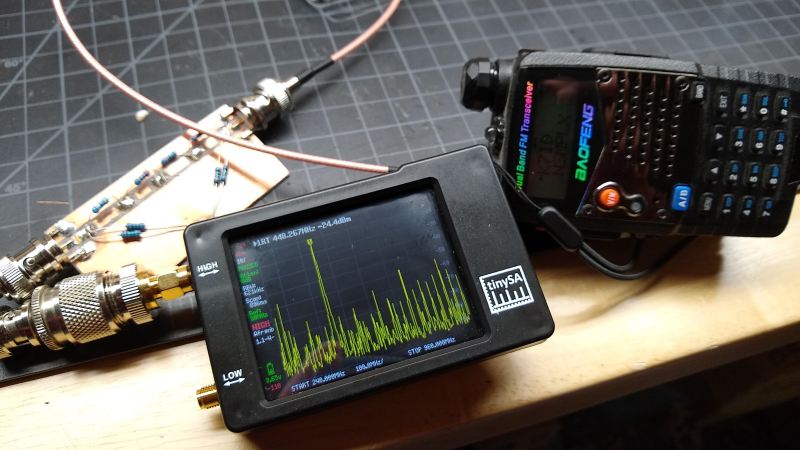
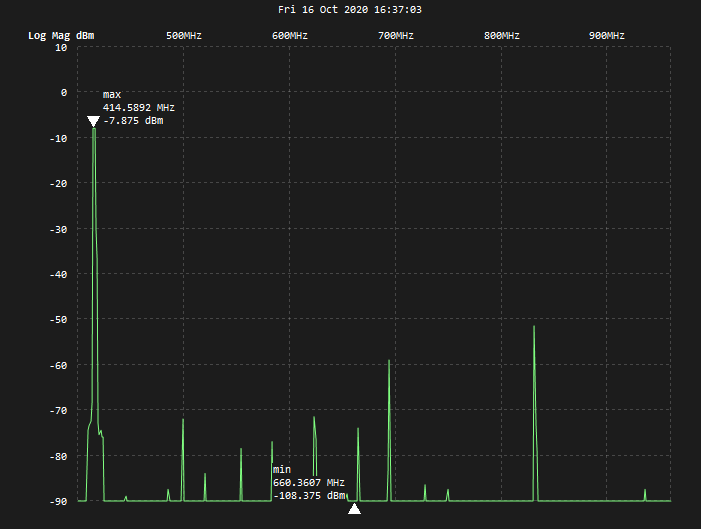

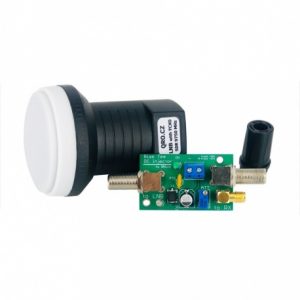
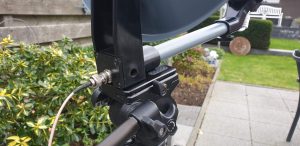
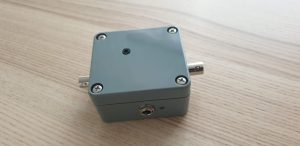 De bias-tee komt dus tussen LNB en ontvanger (tenzij je ontvanger al 12V op de coax heeft) en dan stem je af op 432,750 MHz.
De bias-tee komt dus tussen LNB en ontvanger (tenzij je ontvanger al 12V op de coax heeft) en dan stem je af op 432,750 MHz.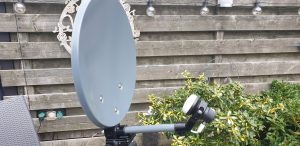 Stel de schotel bijna vertikaal en richt de arm van de LNB richting het zuiden. Draai vervolgens 26 graden naar het oosten (tegen wijzers van de klok in dus).
Stel de schotel bijna vertikaal en richt de arm van de LNB richting het zuiden. Draai vervolgens 26 graden naar het oosten (tegen wijzers van de klok in dus).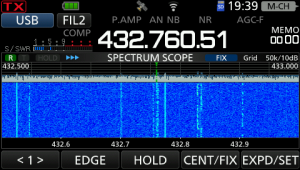 De signalen zijn zeer goed te nemen, alsof het lokale SSB signalen zijn.
De signalen zijn zeer goed te nemen, alsof het lokale SSB signalen zijn. 